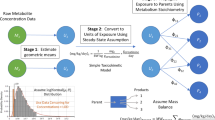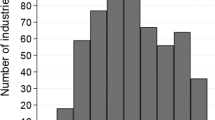Abstract
Regression of log serum concentrations or log urine concentrations on time elapsed after primary exposure ceases is a common method for estimating the elimination rates and corresponding half-lives for environmental contaminants. However, this method produces bias in the presence of ongoing background exposures. A general formula for the amount of bias introduced by background exposures under any single compartment pharmacokinetic model is derived here, and simpler expressions and graphical results are presented for the special case of regularly spaced biomarker measurements. The formulas are also applied to evaluate the potential bias from background exposures in recently published half-life estimates for perfluorooctanoate. These published half-lives are likely to be overestimated because of bias from background exposures, by about 1–26%. Background exposures can contribute substantial bias to half-life estimates based on longer follow-up times, even when the background contribution constitutes a small fraction of total exposure at baseline.
This is a preview of subscription content, access via your institution
Access options
Subscribe to this journal
Receive 6 print issues and online access
$259.00 per year
only $43.17 per issue
Buy this article
- Purchase on Springer Link
- Instant access to full article PDF
Prices may be subject to local taxes which are calculated during checkout

Similar content being viewed by others
Abbreviations
- NHANES:
-
National Health and Nutrition Examination Survey
- PFOA:
-
perfluorooctanoate
References
Foulds G., Shepard R.M., and Johnson R.B. The pharmacokinetics of azithromycin in human serum and tissues. J Antimicrob Chemother 1990: 25 (Suppl A): 73–82.
Brzeznicki S., Jakubowki M., and Czerski B. Elimination of 1-hydroxypyrene after human volunteer exposure to polycyclic aromatic hydrocarbons. Int Arch Occup Environ Health 1997: 70: 257–260.
Obach R.S. Prediction of human clearance of twenty-nine drugs from hepatic microsomal intrinsic clearance data: an examination of in vitro half-life approach and nonspecific binding to microsomes. Drug Metab Dispos 1999: 27 (11): 1350–1359.
Olsen G.W., Burris J.M., Ehresman D.J., Froehlich J.W., Seacat A.M., and Butenhoff J.L., et al. Half-life of serum elimination of perfluorooctanesulfonate, perfluorohexanesulfonate, and perfluorooctanoate in retired fluorochemical production workers. Environ Health Perspect 2007: 115: 1298–1305.
Sobus J.R., McClean M.D., Herrick R.F., Waidyanatha S., Onyemauwa F., Kupper L.L., and Rappaport S.M. Investigation of PAH biomarkers in the urine of workers exposed to hot Asphalt. Ann Occup Hyg 2009: 53 (6): 551–560.
Stahlhut R.W., Welshons W.V., and Swan S.H. Bisphenol a data in NHANES suggest longer than expected half-life, substantial nonfood exposure, or both. Environ Health Perspect 2009: 117: 784–789.
Bartell S.M., Calafat A.M., Lyu C., Kato K., Ryan P.B., and Steenland K. Rate of decline in serum PFOA concentrations after granular activated carbon filtration at two public water systems in Ohio and West Virginia. Environ Health Perspect 2010: 118 (2): 222–228.
Seegal R.F., Fitzgerald E.F., Hills E.A., Wolff M.S., Haase R.F., Todd A.C., Parsons P., Molho E.S., Higgins D.S., Factor S.A., Marek K.L., Seibyl J.P., Jennings D.L., and Mccaffrey R.J. Estimating the half-lives of PCB congeners in former capacitor workers measured over a 28-year interval. J Expos Sci Environ Epidemiol 2011: 21: 234–246.
Brede E., Wilhelm M., Göen T., Müller J., Rauchfuss K., Kraft M., and Hölzer J. Two-year follow-up biomonitoring pilot study of residents’ and controls’ PFC plasma levels after PFOA reduction in public water system in Arnsberg, Germany. Int J Hyg Environ Health 2010: 213 (3): 217–223.
Thuresson K., Höglund P., Hagmar L., Sjödin A., Bergman A., and Jakobsson K. Apparent half-lives of hepta- to decabrominated diphenyl ethers in human serum as determined in occupationally exposed workers. Environ Health Perspect 2006: 114: 176–181.
Calafat A.M., Wong L.-Y., Kuklenyik Z., Reidy J.A., and Needham L.L. Polyfluoroalkyl chemicals in the U.S. population: data from the National Health and Nutrition Examination Survey (NHANES) 2003–2004 and comparisons with NHANES 1999–2000. Environ Health Perspect 2007: 115: 1596–1602.
Steenland K., Deddens J., and Piacitelli L. Risk Assessment for 2,3,7,8-Tetrachlorodibenzo-p-Dioxin (TCDD) based on an Epidemiologic Study. Am J Epidemiol 2001: 172 (7): 451–458.
Seals R., Bartell S.M., and Steenland K. Accumulation and clearance of PFOA in current and former residents of an exposed community. Environ Health Perspect 2011: 119: 119–124.
Michalek J.E., Tripathi R.C., Kulkarni P.M., Gupta P.L., and Selvavel K. Correction for bias introduced by truncation in pharmacokinetic studies of environmental contaminants. Environmetrics 1998: 9: 165–174.
Pinheiro J.C., and Bates D.M. Mixed-Effects Models in S and S-Plus. Springer, New York, NY, 2004.
Romanoff L.C., Li Z., Pittman E.N., Trinidad D.A., Hand K., Lester S., McClean M.D., Bartell S., Webster T.F., and Sjodin A. ##2010. Urinary Excretion Kinetics of Polycyclic Aromatic Hydrocarbon Metabolites Following Dietary Exposure [abstract]. Presented on March 3 at Pittcon 2010, Orlando, FL, Abstract # 2420-26..
DeGroot M.H. Probability and Statistics, 2nd edn. Addison Wesley Publishing Company, Reading, MA 1986.
Acknowledgements
Although no contract or grant funding supported this work, the author would like to acknowledge the C8 Science Panel and the C8 Class Action Settlement Agreement (Circuit Court of Wood County, WV) for funding his residential perfluorooctanoate half-life study that serves as one of the motivating examples.
Author information
Authors and Affiliations
Corresponding author
Ethics declarations
Competing interests
The author declares no conflict of interest.
Appendix
Appendix
Equation (4) can be written more simply in terms of the random variables ɛi and several constants (values that may vary over time, but are fixed quantities not random variables):

Let  . Because ɛi is normally distributed with mean 0, ɛ* must also be normally distributed with mean 0. Thus,
. Because ɛi is normally distributed with mean 0, ɛ* must also be normally distributed with mean 0. Thus,  explaining why the error term does not appear in Eqs. (5), (6) and (7).
explaining why the error term does not appear in Eqs. (5), (6) and (7).
The bias in the half-life estimate is a function of  a quantity that depends on the error variances and is more difficult to calculate. For errors that are small relative to the predicted log biomarker concentrations, the denominator is approximately equal to c1 so
a quantity that depends on the error variances and is more difficult to calculate. For errors that are small relative to the predicted log biomarker concentrations, the denominator is approximately equal to c1 so  the approximation used in Eqs. (8) and (9).
the approximation used in Eqs. (8) and (9).
Alternatively, the delta method states that  for functions g(.) with existent second derivatives.17 The result of this method is thus:
for functions g(.) with existent second derivatives.17 The result of this method is thus:

Therefore with either a relatively small error variance, often a reasonable assumption, or for studies with large enough sample sizes, an underlying assumption for most statistical methods, Eqs. (8) and (9) provide close approximations to the bias in half-life estimates from background exposures under the single compartment pharmacokinetic model for evenly spaced samples.
Rights and permissions
About this article
Cite this article
Bartell, S. Bias in half-life estimates using log concentration regression in the presence of background exposures, and potential solutions. J Expo Sci Environ Epidemiol 22, 299–303 (2012). https://doi.org/10.1038/jes.2012.2
Received:
Accepted:
Published:
Issue Date:
DOI: https://doi.org/10.1038/jes.2012.2
Keywords
This article is cited by
-
Change in decay rates of dioxin-like compounds in Yusho patients
Environmental Health (2016)
-
Urinary polycyclic aromatic hydrocarbon metabolites as biomarkers to woodsmoke exposure — results from a controlled exposure study
Journal of Exposure Science & Environmental Epidemiology (2016)
-
Occurrence, temporal trends, and half-lives of perfluoroalkyl acids (PFAAs) in occupational workers in China
Scientific Reports (2016)
-
Unexpectedly long half-lives of blood 2,3,4,7,8-pentachlorodibenzofuran (PeCDF) levels in Yusho patients
Environmental Health (2015)



